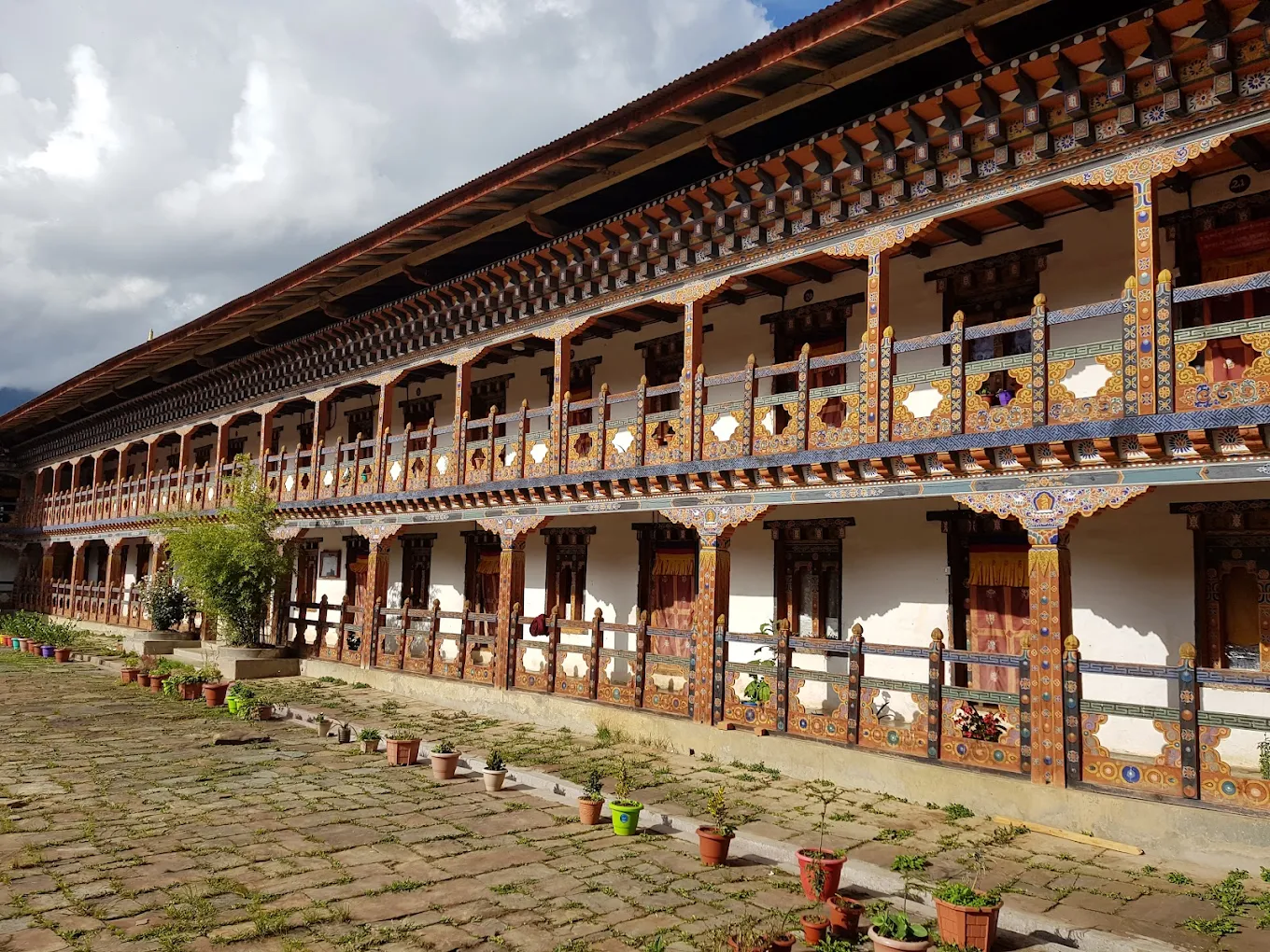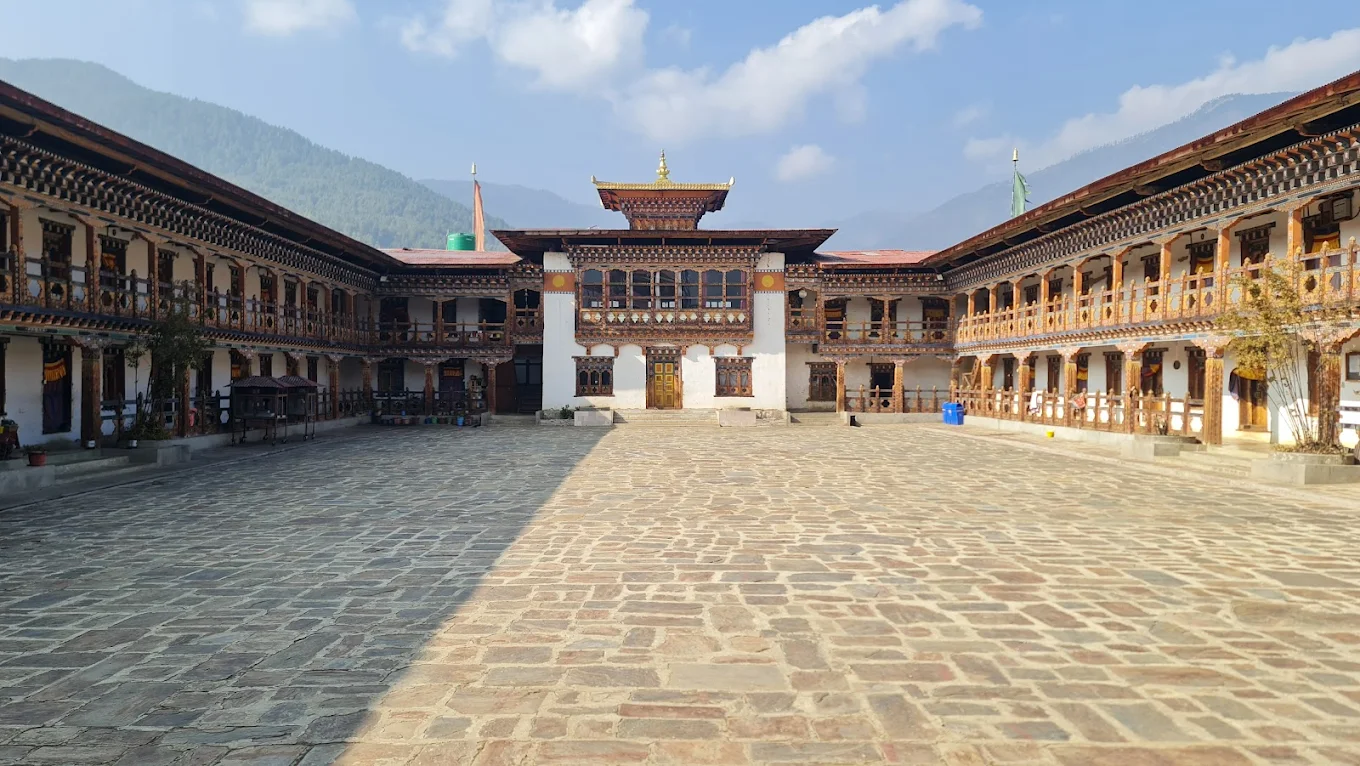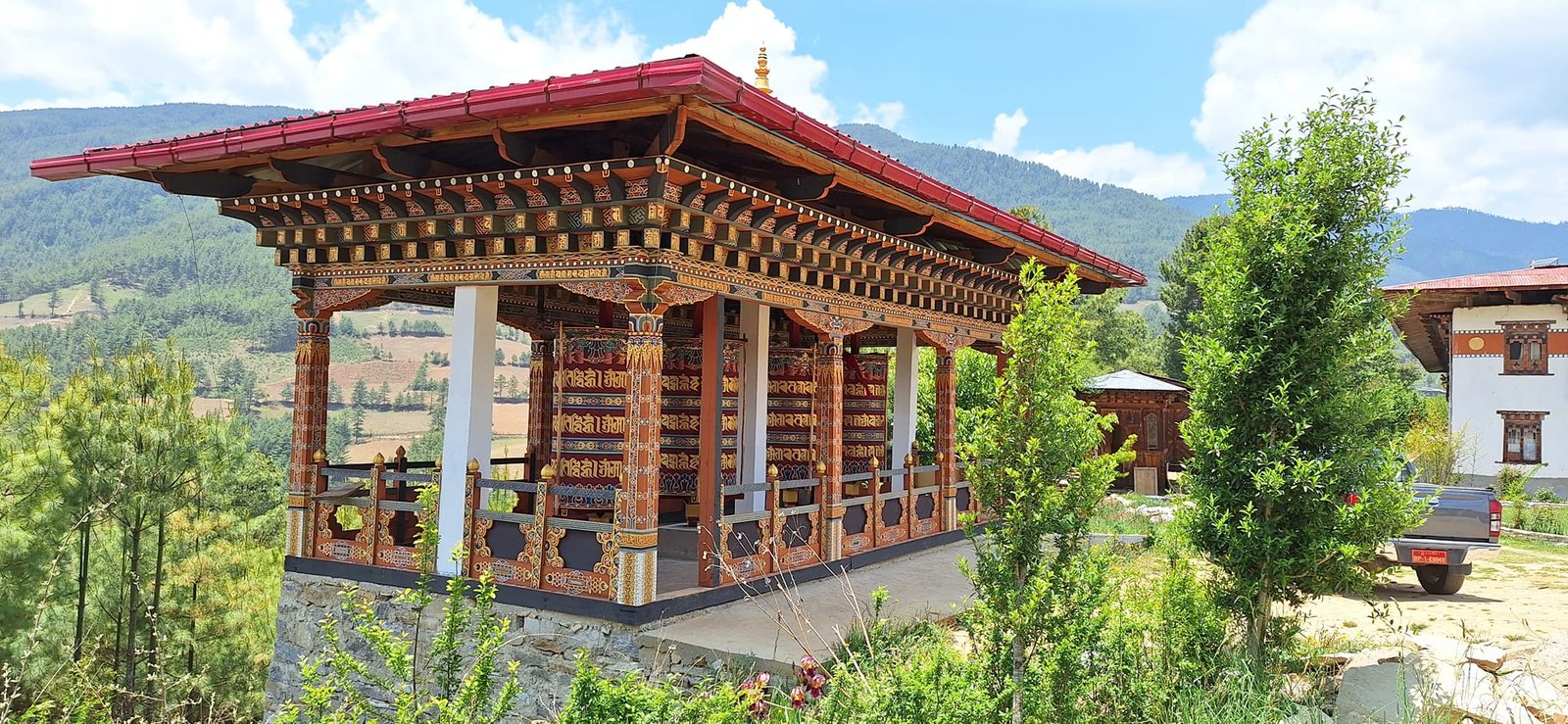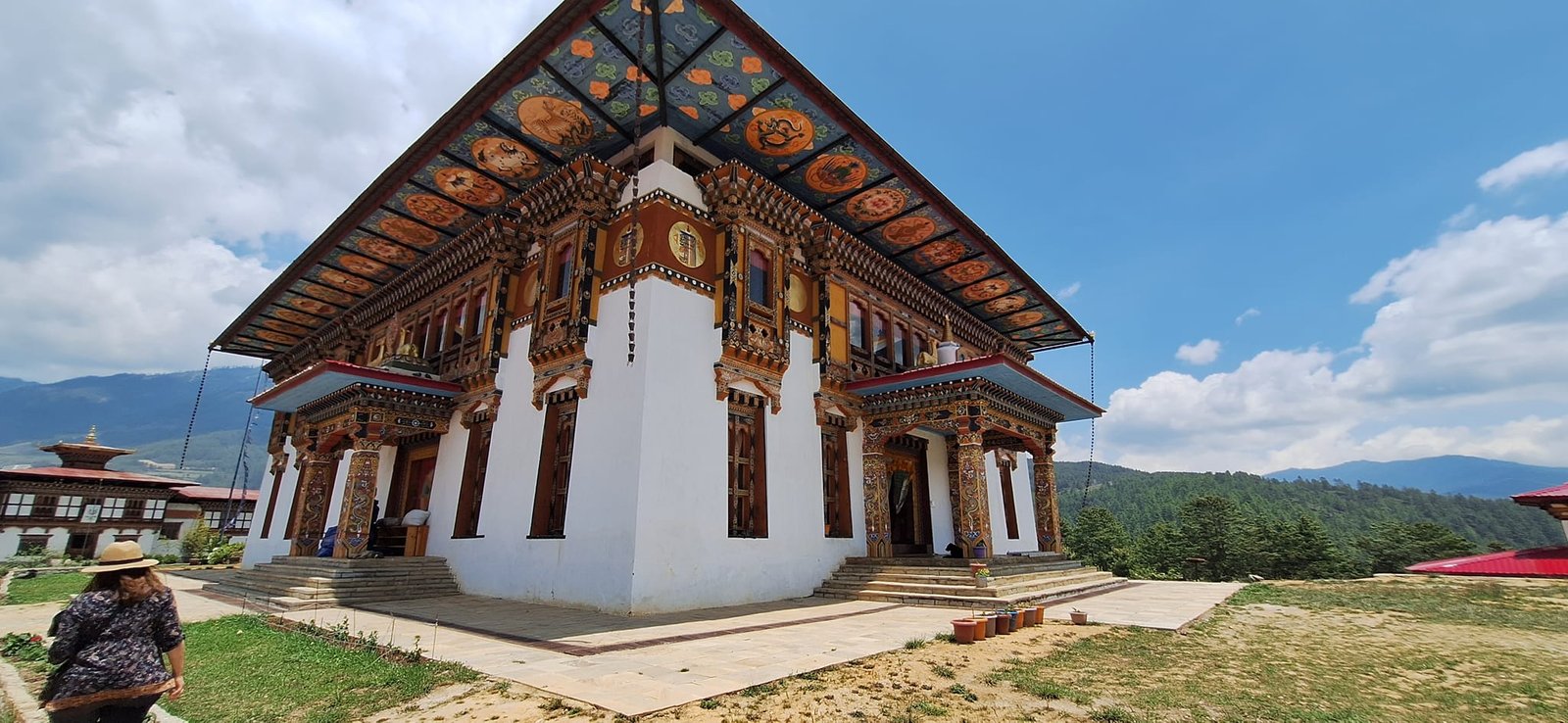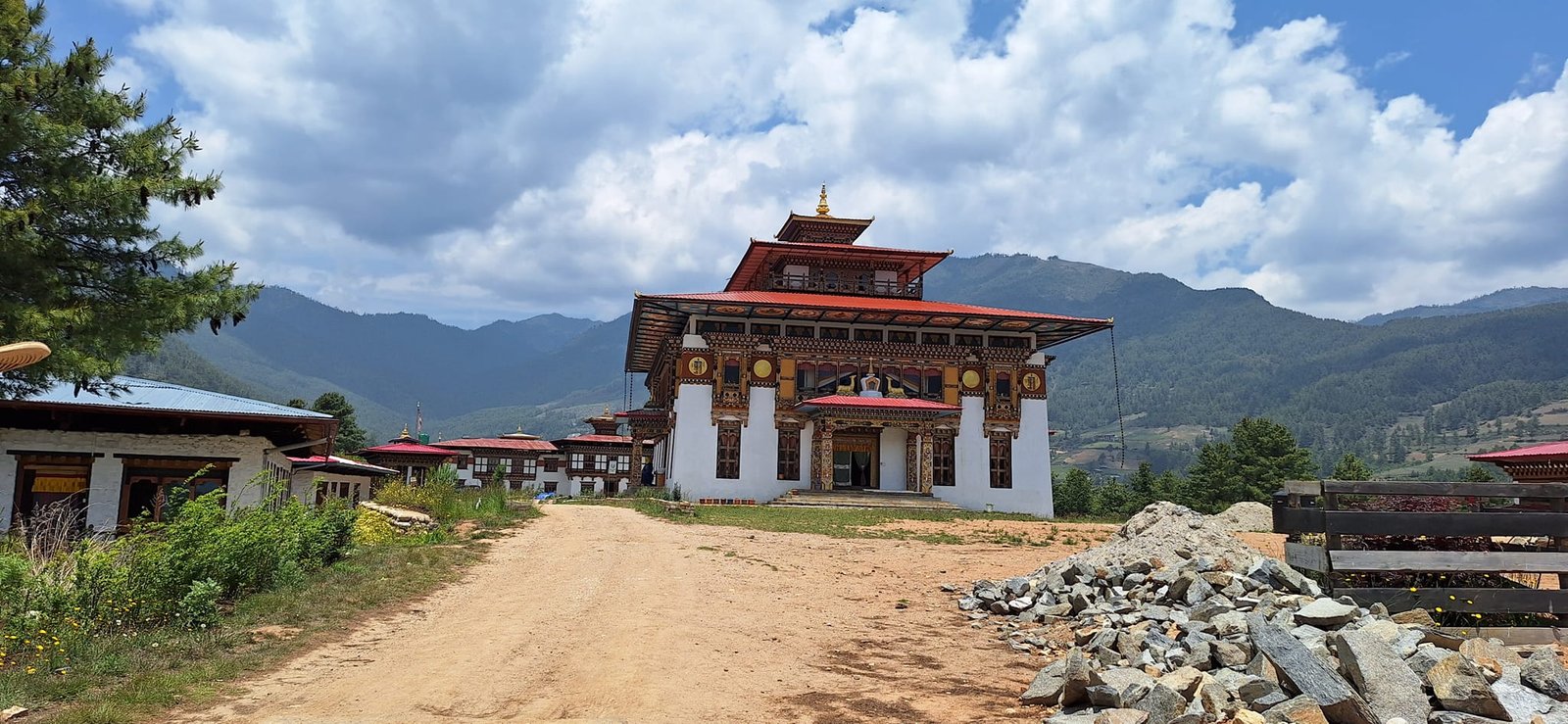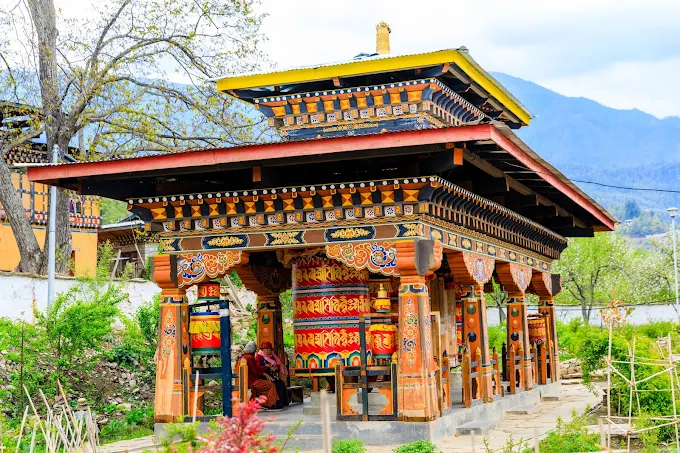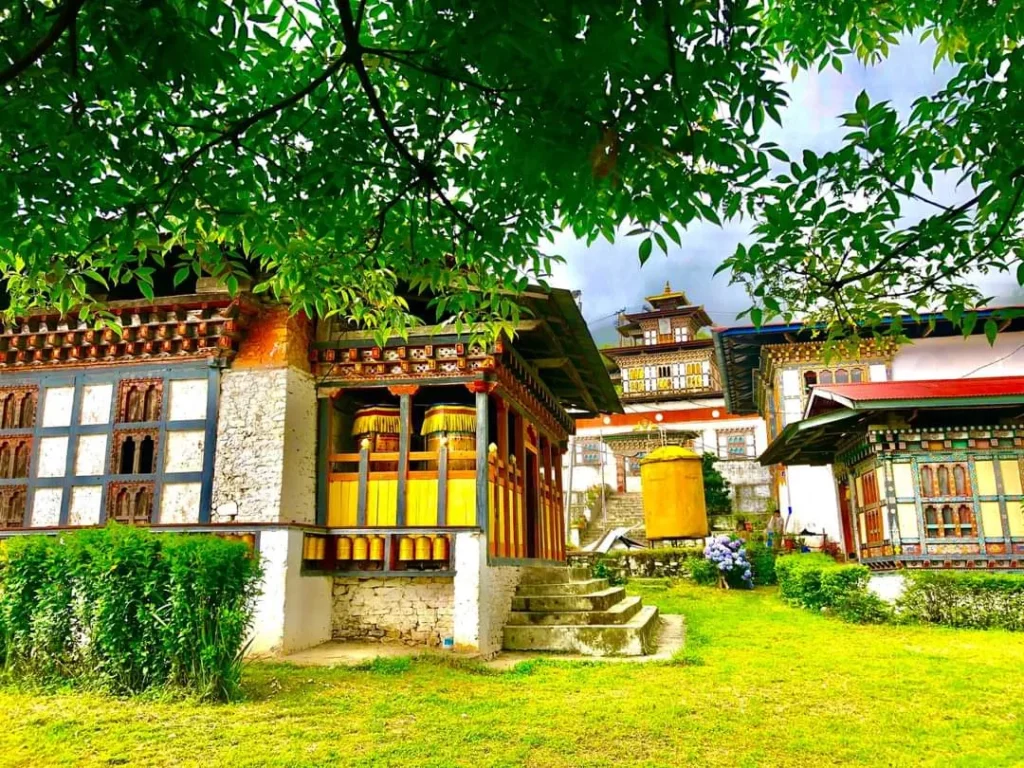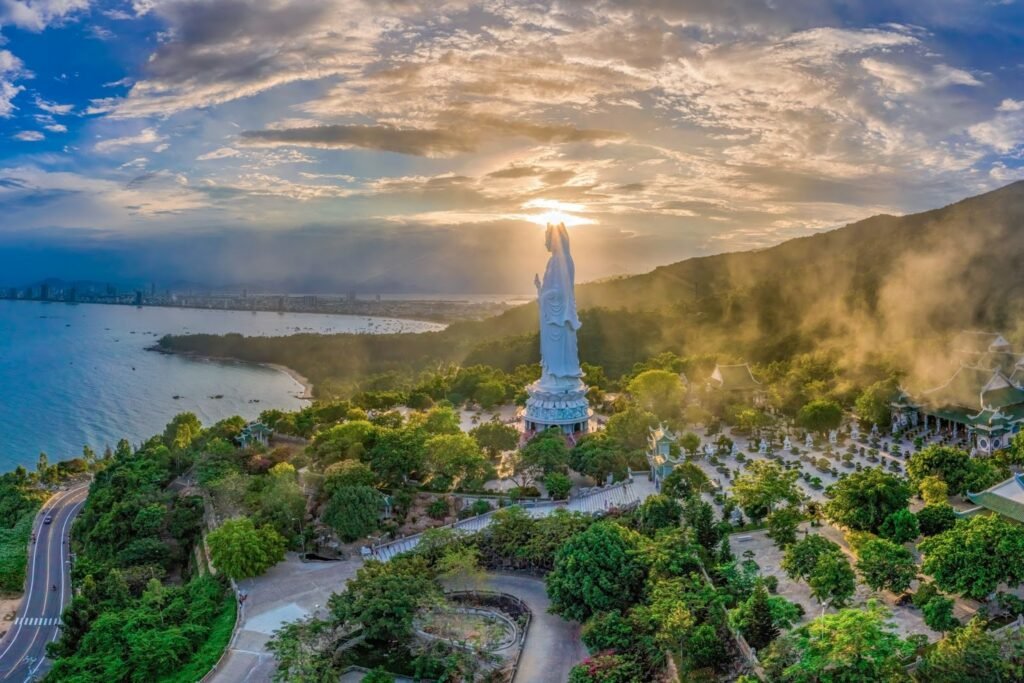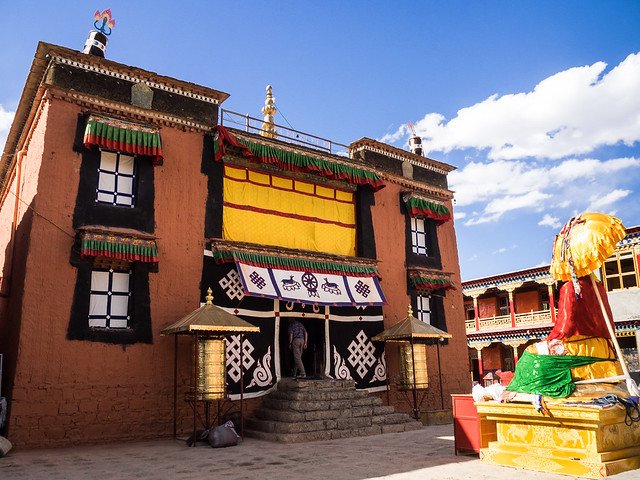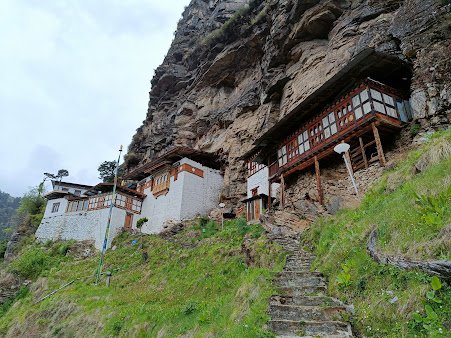Pema Choling Nunnery: The Enlightened Haven of Tang’s Nyingma Sisterhood
Rising gracefully on a windy plateau at the entrance to Tang Valley, where the morning mist dances across a landscape of blue pine hills, Pema Choling Nunnery stands as a beacon of spiritual empowerment, its rammed-earth walls catching the dawn’s gentle light. Within the sacred main temple (lhakhang), nuns chant the Om Mani Padme Hum mantra, their voices resonating around a statue of Guru Rinpoche, embodying the Nyingma Peling tradition. Established in 2001 by His Eminence Gangteng Tulku Rinpoche, this Nyingma nunnery is celebrated as Bhutan’s first shedra (Buddhist college) for women, fulfilling a 15th-century prophecy by Pema Lingpa. The air carries the scent of juniper incense, lit during prayer sessions, while prayer flags flutter against the breeze, blessing the valley below. From its elevated perch in Bumthang Dzongkhag, the sweeping vista of Tang unfolds, connecting the nunnery to Bhutan’s spiritual heart. This sacred retreat invites travelers, seekers, and scholars to ascend its paths and immerse themselves in the transformative legacy of Nyingma devotion.
Whispers of Empowerment: Overview and Significance
Introduction to Pema Choling Nunnery
Pema Choling Nunnery, situated on a plateau in Bumthang Dzongkhag, Bhutan, approximately 5 kilometers from the Jakar-Ura-Mongar highway, stands as a revered Nyingma sanctuary, renowned for its role as the first shedra for women and its location in Tang Valley. A walk or drive from the highway reveals a tranquil retreat where the rustle of pine forests and the sound of monastic chants create a peaceful ambiance. Founded in 2001 by His Eminence Gangteng Tulku Rinpoche, it embodies Bhutan’s Nyingma heritage, blending spiritual practice with educational empowerment. A cultural and spiritual landmark, the nunnery weaves history, learning, and Himalayan reverence into a thriving refuge.
Historical Journey
Pema Choling Nunnery’s history began in 2001 when His Eminence Gangteng Tulku Rinpoche, the 9th reincarnation of Pema Lingpa’s lineage, established it to fulfill a 15th-century prophecy by Pema Lingpa that a great center of learning for women would rise in Tang Valley. Initially, nuns lived in simple huts, settling the site with community support. From 2005, construction of rammed-earth buildings with Bhutanese woodwork began, led by the nuns alongside workers from a Thimphu vocational school and local villagers. The nunnery evolved into a shedra, offering a 9-year masters program in Buddhist philosophy, and now houses around 100 nuns aged 12 to 70, reflecting its growth as a spiritual and educational hub.
Cultural Significance
- Nyingma Devotion: Rooted in the Nyingma Peling tradition, the nunnery venerates Guru Rinpoche and Pema Lingpa, emphasizing Dzogchen meditation and learning.
- Bhutanese Heritage: A spiritual and educational anchor, it preserves rituals like mantra recitation and debate, reflecting national identity.
- Women’s Empowerment: As the first shedra for women, it enhances its role in gender equality.
- Regional Influence: Pilgrimages draw devotees from Bumthang and central Bhutan, fostering community ties.
Unique Legacy
- Plateau Perch: Its location 5 kilometers from the highway offers a serene retreat, distinct among Bhutan’s nunneries.
- Pema Lingpa’s Prophecy: The 15th-century vision holds sacred potency, a verified cultural narrative.
- Shedra Resilience: The 2005 construction reflects Bhutanese dedication to education.
- Cultural Symbol: Its female monastic community mirrors Bhutan’s evolving spirituality.
Community and Global Impact
- Local Devotion: The nunnery hosts prayers and educational events, strengthening Bumthang’s Nyingma ties.
- Pilgrimage Hub: Visitors are drawn by its shedra and valley views.
- Global Appeal: International supporters and meditators seek its empowerment mission.
- Cultural Dialogue: Shared rituals unite Bhutanese and global visitors.
Modern Relevance
- Spiritual Retreat: Pema Choling offers a haven for mindfulness in its plateau seclusion.
- Cultural Preservation: It safeguards Nyingma practices, ensuring Bhutan’s heritage endures.
- Educational Role: The shedra supports female monastic education, inspiring growth.
Historical Anecdotes
- Pema’s Prophecy: His 15th-century vision inspired its founding.
- Tulku’s Vision: Gangteng Rinpoche’s 2001 establishment marked a milestone.
- Hut Beginnings: The 2001 huts reflect early resilience.
Social Role
- Community Hub: Prayers and debates unite Bumthang’s Buddhists.
- Educational Center: Nuns train in Buddhist philosophy, nurturing spiritual depth.
- Charitable Spirit: Communal support reflects Nyingma compassion.
Artistic Influence
- Thangka Art: Murals of Guru Rinpoche inspire Bhutanese artists.
- Cultural Icon: The Tang view graces local imagery.
- Festival Art: Prayer flags showcase Bhutanese craftsmanship.
Pema Choling Nunnery’s plateau perch, where Gangteng Tulku Rinpoche fulfilled Pema Lingpa’s prophecy, weaves a narrative of devotion and empowerment that defines Bhutan’s Nyingma heritage. From its 2001 founding to its role as a shedra, the nunnery’s history resonates with the harmony of Tang Valley, uniting nuns and pilgrims. Its sacred halls and scenic trails set the stage for an architectural tapestry that mirrors its Himalayan soul. As we delve into its physical and spiritual features, Pema Choling’s design reveals how its serene beauty nurtures profound faith and education.
Crafted by the Plateau: Architectural and Spiritual Features
Iconic Design
Pema Choling Nunnery’s architecture blends Nyingma simplicity with its plateau setting, creating a sanctuary that harmonizes with Tang’s valley landscape. Rammed-earth walls and wooden roofs, adorned with prayer flags, rise from the plateau, reflecting Bhutanese modesty. The multi-building layout, centered on the main lhakhang, prioritizes educational and ceremonial functions, with courtyards fostering community. Its perch above Tang Valley enhances its sacred resonance, tying the nunnery to Bhutan’s Himalayan ethos.
Key Structures
- Main Lhakhang: The spiritual core, housing Guru Rinpoche’s statue, built from 2005.
- Shedra Classrooms: Educational spaces for the 9-year program, constructed post-2005.
- Hostel Buildings: Residential areas for 100 nuns, expanded with community effort.
- Chorten Courtyard: A small area with prayer wheels, used during rituals.
- Prayer Flag Poles: Structures strung with flags, dotting the plateau.
Worshipped Statues
- Guru Rinpoche (Padmasambhava): A bronze statue, symbolizing wisdom, radiates spiritual guidance.
- Pema Lingpa: A statue representing treasure revelation, stands prominently.
- Spiritual Role: Nuns offer butter lamps to Guru Rinpoche, seeking blessings.
Materials and Techniques
- Construction: Rammed earth and timber, joined with traditional Bhutanese methods, ensure durability.
- Artistry: Simple murals, crafted by local artisans, reflect Nyingma style.
- Cultural Essence: The design prioritizes educational simplicity, distinct from monasteries.
Signature Elements
- Plateau Perch: The 5-kilometer highway proximity offers a serene setting.
- Shedra Legacy: The classroom buildings anchor the educational narrative.
- Prayer Flags: Fluttering flags carry blessings across the valley.
Preservation Efforts
- Construction (2005): Built by nuns and villagers, preserving Bhutanese style.
- Challenges: Weather erosion affects earth walls, requiring maintenance.
- Modern Additions: Solar lights enhance evening accessibility.
Environmental Integration
- Plateau Harmony: The nunnery’s design respects Tang’s ecosystem.
- Eco-Practices: Nuns maintain grounds and protect pine forests.
- Wildlife Haven: Birds nest nearby, enhancing serenity.
Landscape Integration
- Plateau Perch: Enhances ceremonial focus with valley views.
- Tang Vista: The valley mirrors inner peace.
Pema Choling Nunnery’s rammed-earth lhakhang and sacred courtyards, overlooking Tang Valley, are more than architectural marvels; they are sanctuaries for the Nyingma practices that define its spiritual soul. The statue of Guru Rinpoche, illuminated by butter lamps, anchors rituals that connect nuns to Bhutan’s spiritual lineage. These hallowed spaces, alive with chants and education, invite visitors to engage with the nunnery’s living traditions. As we explore its rituals, Pema Choling’s role as a meditative and educational retreat comes to life, guiding devotees toward empowerment and enlightenment.
Rites of the Sisterhood: Rituals and Practices
Daily Sacred Rites
- Morning Chanting: Nuns recite the Om Mani Padme Hum mantra at dawn, fostering compassion.
- Meditation Sessions: Silent meditation, held twice daily, centers on Dzogchen practices.
- Butter Lamp Offerings: Nuns light lamps before Guru Rinpoche, praying for wisdom.
Unique Practices
- Debate Sessions: Nuns engage in theological debates, a shedra tradition.
- Thangka Rituals: The large thangka is prepared for festivals, a Nyingma practice.
- Signature Ritual: Offering khata scarves during debates, tied to educational legacy.
Festival Traditions
- Nyimalung Tsechu (8th–10th of 5th lunar month): A three-day festival with masked dances and thangka display.
- Kaling Zhitro Drubchen (1st–15th of 1st lunar month): A 15-day ritual featuring music.
- Lhabab Duchen: Ceremonies honor the Buddha’s descent, with chorten circuits.
- Statue Veneration: Guru Rinpoche’s statue is adorned with silk during festivals.
Visitor Engagement
- Accessible Rituals: Visitors can join chants or observe debates, guided by nuns.
- Offerings: Butter lamps and prayer flags, available at the nunnery, invite participation.
- Nyingma Etiquette: Bow before statues and maintain silence during rituals.
Spiritual Community Roles
- Nuns: Around 100 nuns, led by the abbess, conduct rituals and studies.
- Lamas: Senior nuns guide debate and puja practices.
- Lay Devotees: Bumthang villagers maintain grounds and support events.
Interfaith Connections
- Syncretic Practices: Some blend Nyingma rites with local traditions, honoring spirits.
- Outreach: Festivals welcome diverse faiths, fostering unity.
- Education: Nuns share Nyingma teachings with visitors.
Ritual Symbolism
- Butter Lamps: Represent wisdom illuminating learning.
- Khata Offerings: Symbolize purity and devotion.
- Thangka Display: Signifies liberation by sight.
Seasonal Variations
- Summer Rites: Vibrant with valley blooms, ideal for Nyimalung Tsechu.
- Winter Retreats: Cold enhances meditation focus.
- Monsoon Chants: Rain amplifies mantra resonance.
Monastic Life
- Daily Routine: Nuns rise at 5:00 AM for chants, meditation, and study.
- Community Service: Nuns guide visitors and maintain the nunnery.
- Training Hub: Nuns learn Nyingma philosophy, supporting Bumthang’s faith.
Pema Choling Nunnery’s rituals, from the Om Mani Padme Hum mantra to debate sessions, breathe life into its plateau sanctuary, connecting devotees to the Nyingma lineage. The nunnery’s spiritual practices, rooted in Bhutan’s educational faith, invite visitors to engage with its empowered heart, whether through chants or observing studies. For travelers, these rites offer a glimpse into Tang’s sacred traditions, accessible within its valley grounds. As we turn to visitor information, Pema Choling’s plateau setting guides practical planning, ensuring a meaningful journey to this enlightened retreat.
Journey to the Plateau: Visitor Information
Navigating to Pema Choling Nunnery
- Location: Bumthang Dzongkhag, 5 kilometers from the Jakar-Ura-Mongar highway, accessible via a trail from the road.
- Landmarks: Near Tang Valley and blue pine hills, with Dzongkha and English signs.
- Routes: Walk from the highway (15–20 minutes) or drive to the plateau base.
Address of Pema Choling Nunnery
- Dzongkha: Pema Choling Anim Dratshang, Bumthang Dzongkhag, Bhutan.
- English: Pema Choling Nunnery, Bumthang District, Bhutan.
Visiting Hours and Etiquette
- Hours: Open daily, 6:00 AM–5:00 PM, with ceremonies and classes varying by schedule.
- Etiquette: Dress modestly, remove shoes before lhakhang, and avoid disrupting studies.
- Nyingma Custom: Offer butter lamps with both hands and bow to statues.
Transport Options
- By Foot: Walk from the highway (15–20 minutes, easy difficulty).
- By Vehicle: Drive to the plateau access point, then walk.
- By Bicycle: A scenic ride suits active visitors to the base.
Accessibility and Safety
- Mobility: Gentle slopes may challenge those with mobility issues; no ramps available.
- Safety: Stable paths with guideposts; carry water for the walk.
- Tips: Wear comfortable shoes and bring layers for weather changes.
Amenities and Surroundings
- Facilities: Basic restrooms near the nunnery; no shops on-site.
- Nearby: Mebar Tsho and Jakar Dzong, within 10–15 km, offer cultural experiences.
- Dining: Picnic areas encourage packed meals, with options near Tang.
Immersive Visitor Tips
- Best Timing: Early morning visits offer quiet chants and cooler weather.
- Sensory Moments: Inhale pine-scented air and hear monastic debates.
- Statue Connection: Offer butter lamps to Guru Rinpoche and reflect briefly.
- Festival Planning: Attend Nyimalung Tsechu for thangka displays.
Nearby Cultural Experiences
- Mebar Tsho: The Burning Lake, 10 km away, holds spiritual significance.
- Jakar Dzong: A fortress, 15 km away, blends spirituality and history.
- Kurjey Lhakhang: An ancient site, 12 km away, offers sacred relics.
Photography Tips
- Best Angles: Capture the lhakhang at sunrise for golden light.
- Respectful Shots: Avoid photographing classes or rituals without permission.
- Scenic Views: The Tang Valley offers stunning vistas.
- Equipment: A smartphone or lightweight camera suffices.
The journey to Pema Choling Nunnery, guided by Tang’s plateau trails, is a pilgrimage that blends spiritual discovery with educational empowerment, inviting visitors to engage with its Nyingma traditions. The nunnery’s lhakhang and courtyards, vibrant with chants and debates, offer a window into Bhutan’s sacred heart, where wisdom feels accessible. Beyond its plateau beauty, Pema Choling’s deeper cultural and spiritual significance enriches the experience, revealing the essence of Himalayan Buddhism. As we explore these insights, the nunnery’s role as a beacon of faith and learning comes into sharper focus, deepening our connection to its sacred legacy.
Insights of the Plateau: Cultural and Spiritual Reflections
Nyingma Philosophy
Pema Choling Nunnery embodies Nyingma’s core: compassion and wisdom through Dzogchen meditation and education. Guru Rinpoche and Pema Lingpa inspire devotees, reflected in chants and debate rituals. Mahamudra teachings emphasize direct realization, guiding nuns toward enlightenment.
Environmental Spirituality
The nunnery’s plateau perch ties it to Himalayan reverence for nature. Tang’s pine hills and valley views foster meditative calm, with offerings honoring local spirits. The landscape invites reflection on harmony with the natural world.
Artistic Symbolism
Murals depict Guru Rinpoche’s wisdom, symbolizing liberation. The thangka represents enlightenment by sight, while prayer flags balance elements. These elements weave Nyingma ideals into the nunnery’s aesthetic.
Community Resilience
Founded by Gangteng Tulku Rinpoche’s followers, Pema Choling reflects Bhutanese perseverance through time. Its 2005 construction showcases collective faith, sustained by community efforts.
Environmental Stewardship
The nunnery’s grounds foster Buddhist eco-ethics. Nuns protect trails and pine forests, urging visitors to honor the plateau’s sanctity.
Meditative Practices
Nyingma meditation, including Dzogchen, cultivates awareness. The lhakhang offers spaces for retreat, guided by nuns, amplifying inner peace.
Cultural Narratives
- Pema’s Prophecy: His 15th-century vision inspires devotion.
- Tulku’s Founding: The 2001 establishment links past and present.
- Festival Lore: Nyimalung Tsechu carries Nyingma traditions.
Historical Context
- Nyingma Roots: Pema Lingpa’s prophecy shaped its identity.
- Tulku’s Era: The 2001 founding defined its growth.
- Community Continuity: Construction ensures its legacy.
Reflecting on the Journey
Pema Choling Nunnery, cradled on Tang’s sacred plateau, is a sanctuary where wisdom meets empowerment. Its lhakhang and courtyards, alive with Guru Rinpoche’s legacy, embody Bhutan’s Nyingma soul, inviting all to seek enlightenment. The nunnery’s trails, worn by decades of nuns, tell a story of devotion, rooted in Himalayan faith. Whether meditating before Pema Lingpa, witnessing debates, or tracing Bhutan’s educational heritage, visitors find a space to reflect and connect. As you descend, the pine scent and prayer flags’ flutter linger, a reminder that peace is always within reach.
